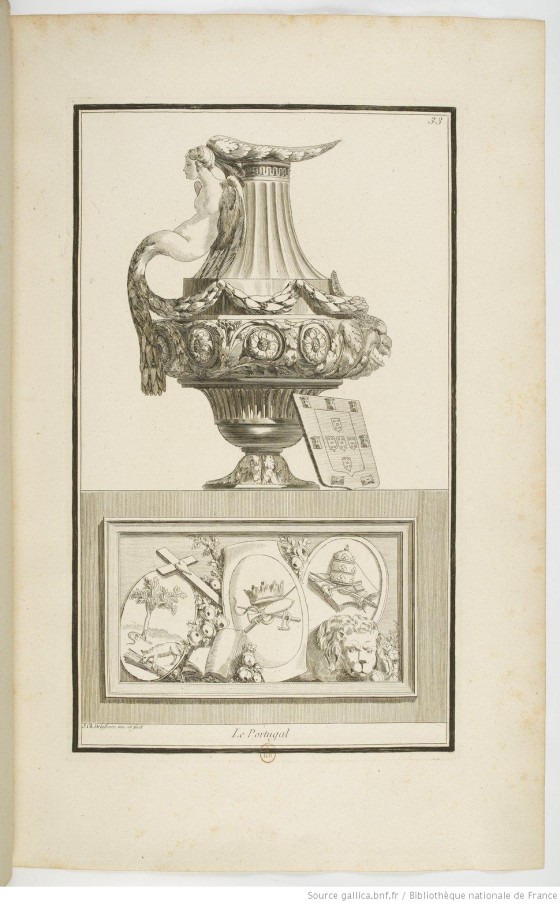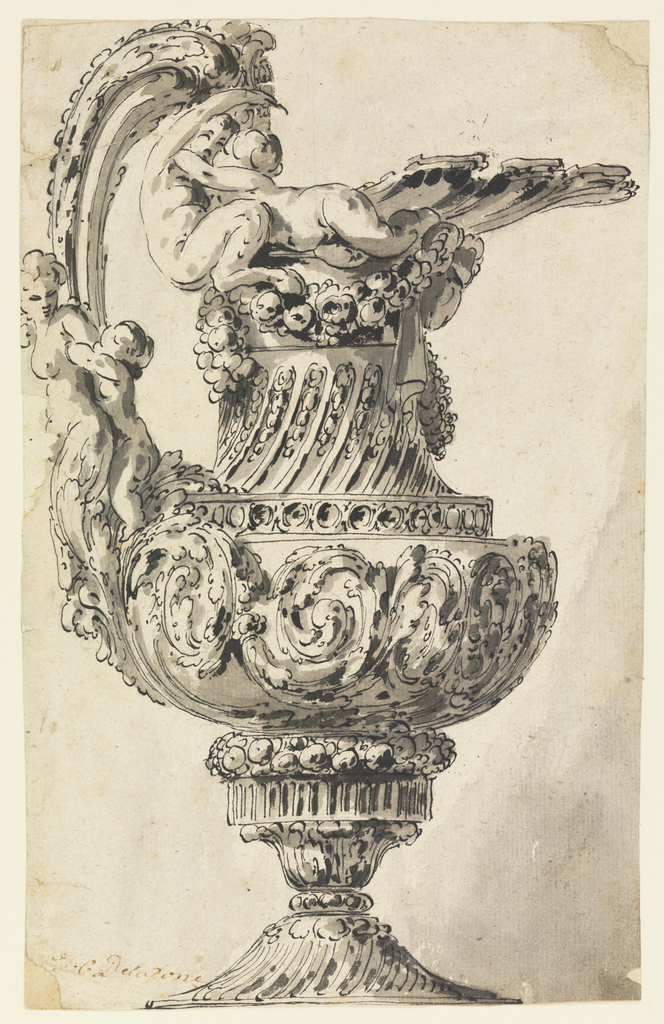This is a design for an ewer by the Parisian architect, designer, decorator and print maker, Jean-Charles Delafosse (1734-91). Delafosse engaged in diverse artistic productions producing urban planning proposals, architectural plans, furniture designs as well as drawings of ruin capriccios and allegorical and ornamental prints. His designs were widely circulated across France, England, and Germany and had a profound impact in the development of the goût grec (Greek style), an early form of neoclassicism that emerged around 1760s.
This drawing for an ewer modifies the traditional form of an oinochoe, a type of Greek vase used to hold wine or water. Acanthus leaves scroll across the body of the ewer with festoons of berries, flowers and laurel leaves across the neck. The base and the neck of the ewer are fluted with chains of husks ornamenting the filets. The handle is a fusion of a dramatically arched leaf and a nymph whose lower body blends into the body of the vase. A satyr embracing a woman rests on the leafy lip of the vessel. These mythological figures are not only similar in style to those by Enea Vico, Jacques Androuet du Cerceau, and Polidoro da Caravaggio, but can also be compared to the figures in mythological cabinet pictures.
This design was never realized in other media and was likely intended to be a paper design. Delafosse frequently used his fantastical ornament, furniture and landscape compositions as a means to explore and expand upon his artistic vocabulary. Vases, in particular, were leitmotifs for the Greek style and are nearly ubiquitous throughout Delafosse’s designs for overdoor ornaments, fountains, and consoles. Versions of this ewer are incorporated in the iconography of Abundance, in the emblem for Humility and as allegory for the country of Portugal in his publication, the Nouvelle Iconologie Historique (1768).

Print, Le Portugal, 1768; Designed by Jean-Charles Delafosse (1734-89); Plate 33 in Nouvelle iconologie historique (1768); Bibliothèque nationale de France, département Estampes et photographie, Inv. no. FOL-TD-3
The latter was an ambitious publication that merged the ornamental pattern books used by marchand-merciers and artisans with the iconological tradition. In these designs, vases were liberated from their functional duties as appropriated as a template for ornamental inventions.
Throughout the eighteenth-century, artists and designers such as François Boucher, Edmé Bouchardon, Jacques Saly, and Ennemond-Alexandre Petitot produced series of etchings and engravings on vase designs while painters and architects such as Joseph-Marie Vien, François-Joseph Bélanger, and Jean-Laurent Legeay incorporated vases into their diverse artistic output. While Delafosse too published a book of vases under Cahiers des vases et tombeaux and although vase designs were included in his Cahiers de décorations, sculptures, orfévreries et ornenements as well as in his Nouvelle Iconologie Historique, his engraved designs are significantly more architectonic and austere. Still, as there are several drawings by Delafosse executed with the same media that expand upon ornamental variations for the ewer, it may very well be that he intended to engrave these designs for a book of vases. Conversely, this drawing can also be interpreted as an exploration of his visual vocabulary by pushing the limits of classical design paradigms. In fact, another drawing of an ewer design by Delafosse in the Cooper Hewitt collection (Inv. No. 1911-28-50) takes the mythology of Leda as its decorative subject.
The French architect and académician Jacques François Blondel considered Delafosse’s classically inspired style just as extravagant as Juste-Aurèle Meissonnier’s luxuriant rococo language writing, “if the productions of Meissonnier and Delafosse fall unfortunately into your hands, and you glance through them, don’t give them your vote: the one is an offensive frivolity, the other a stupefying weight.” [1]
Perhaps Blondel recognized that the Delafosse’s Greek style was in fact rooted in the legacy of the sensual rococo style, with the turning point embodied in this ewer design.
[1] Jacques François Blondel, L’ Homme Du Monde Éclairé Par Les Arts. Tome II (Paris: Chez Monory, 1774), p. 48.
Cabelle Ahn is a graduate intern in the Department of Drawings, Prints and Graphic Design at the Cooper Hewitt, Smithsonian Design Museum. She received her MA in Art History from the Courtauld Institute of Art and is currently studying eighteenth century decorative arts at the Bard Graduate Center.
